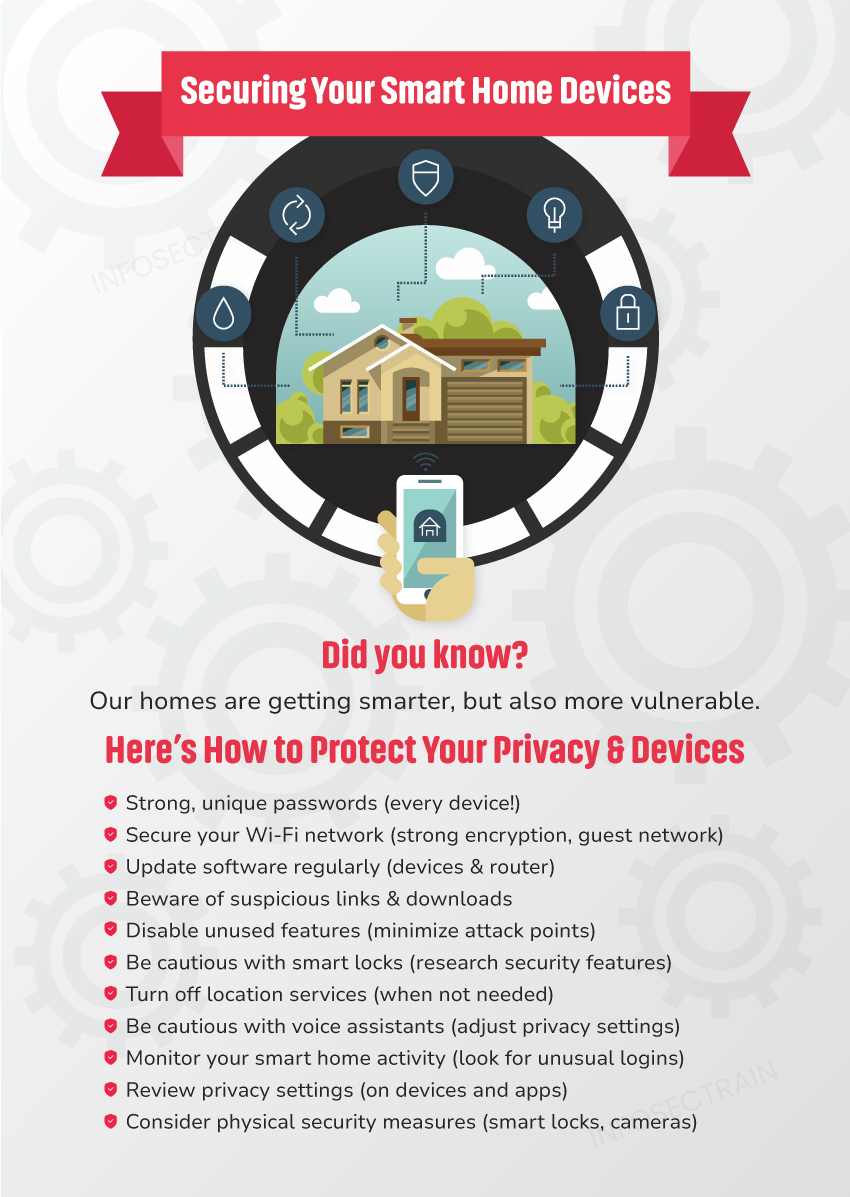Securing Your Smart Home in a Connected World
Imagine a world where your lights adjust to your mood, your thermostat anticipates your needs, and all it takes is a simple voice command. Smart home technology offers this futuristic convenience, seamlessly weaving into the fabric of our daily lives.

However, this interconnectedness presents a hidden vulnerability: cyberattacks. Hackers can exploit weaknesses in smart home devices, potentially gaining access to your network, stealing sensitive data, or even disrupting your smart home’s operation.
But worry not! Securing your smart home devices doesn’t require a cybersecurity degree. By following these actionable steps, you can ensure the security of your smart home with peace of mind.

1. Strong Passwords and Encryption:
- Unique and Complex Passwords: Resist the urge to reuse the same password for all your devices. Create unique, complex and strong passwords for smart homes. Additionally, employing a password manager can aid in the creation and secure storage of robust passwords.
- Enable Encryption: Many smart home devices offer encryption features. Enabling encryption scrambles data transmitted between your device and the manufacturer’s servers, making it virtually unreadable for prying eyes.
2. Secure Your Wi-Fi Network:
- Strong Wi-Fi Password: Use a strong password for your Wi-Fi network, similar to the strategy used for individual devices. Choose a combination of uppercase and lowercase letters, numbers, and symbols.
- Guest Network: Consider creating a separate guest network for visitors. This limits their access to your main network where your smart home devices reside.
- Enable WPA2 Encryption: Ensure your Wi-Fi network uses WPA2 encryption (or WPA3 if available). This industry standard scrambles data transmitted over your Wi-Fi network, making it significantly harder for hackers to intercept.
- Disable WPS (Wi-Fi Protected Setup): WPS can introduce security vulnerabilities. If you haven’t already set up devices with WPS, consider disabling it for better protection.
3. Regular Software Updates:
- Automatic Updates: Whenever possible, enable automatic software updates for your smart home devices. By doing so, you can guarantee that you’ve installed the most recent security patches, thereby resolving any recently identified vulnerabilities.
- Regular Manual Checks: Don’t rely solely on automatic updates. Conduct regular manual checks for firmware updates. Manufacturer websites typically list available updates.
4. Scrutinize Third-Party App Permissions:
Many smart home devices rely on third-party apps for control and functionality. Be cautious about the permissions you grant these apps. Grant only the minimum level of access required for the app to function.
5. Guest Access and User Accounts:
- Limit Guest Access: Restrict guests’ access to your smart home features. Consider creating separate accounts for family members with varying levels of control.
- Disable Unused Features: If you’re not using a particular feature on your smart home device, disable it. This minimizes the potential attack surface that hackers can exploit.
6. Be Mindful of What Data You Share:
Smart home devices can collect various data about your habits and routines. Review your device’s privacy settings and limit the amount of data collected to what’s essential for their operation.
7. Monitor Your Network Activity:
There are tools available to monitor your network activity. These tools can help you identify unusual activity that might indicate a compromised device.
8. Research Before You Buy:
Before purchasing a new device, research its security features. Look for devices with a good reputation for security and those that are actively supported by the manufacturer with regular software updates.
9. Common Sense Still Reigns Supreme
- Beware of Phishing Attacks: Phishing emails or deceptive websites can trick you into revealing your login credentials for your smart home devices. Exercise caution when clicking on links of questionable origin or downloading attachments from unknown sources.
- Physical Security: While most security measures focus on digital measures, don’t neglect physical security. For devices with voice control features, consider disabling them when you’re not home to prevent unauthorized access.
10. Advanced Techniques for Smart Home Security
- Segment Your Network: Dividing your network into separate segments can limit the damage if one device becomes compromised. This may require advanced networking knowledge or assistance from a network security professional.
- Use a VPN: A Virtual Private Network (VPN) encrypts all your internet traffic, including data flowing to and from your smart home devices. This adds an extra layer of protection.
- Invest in a Security System: Consider integrating your smart home devices with a comprehensive home security system. This may include features like motion sensors, door and window sensors, and security cameras.
Embrace the Future with InfosecTrain
Smart home technology offers a glimpse into a future filled with convenience and innovation. By prioritizing security and following these best practices for smart home security, you can embrace these advancements while safeguarding your privacy and maintaining control over your connected home.
The future of technology is constantly evolving, and so are the security threats that accompany it. InfosecTrain empowers you to stay ahead of the curve with a comprehensive suite of cybersecurity courses designed to help you navigate the constantly changing digital landscape. Whether you’re a homeowner seeking to secure your smart home or an IT professional looking to specialize in IoT security, InfosecTrain offers a variety of courses tailored to your specific needs.




 1800-843-7890 (India)
1800-843-7890 (India) 
